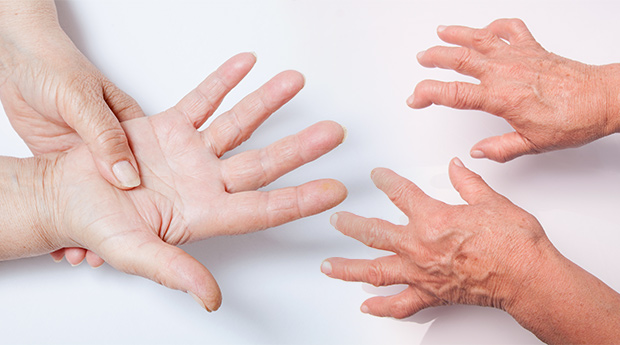Rheumatoid arthritis (RA) is an autoimmune disorder of connective tissue; this tissue is the basis of muscles, joints, ligaments, blood vessels and much else. Being autoimmune in nature means that RA involves the formation of antibodies which then proceed to destroy the connective tissue.
No one knows quite why this happens but there seems to be a genetic link in some people. Women are three times more likely to suffer from the disease than men, particularly in the younger age groups. Some people only develop the disease mildly and for a short period, in others it can take a more severe and prolonged course.
The most obvious manifestation of RA is in the joints. These initially become stiff and painful followed later by swelling and inflammation. If the disease progresses the joints may become deformed and permanently damaged.
Joints Most Commonly Affected in RA
Usually a number of joints are affected, commonly those of the hands and feet but any joint is susceptible such as the knees, elbows, shoulders, hips and spine.

Other Tissues Affected in RA
Because RA attacks connective tissue which forms the basis of almost every tissue in the body, virtually any part of the body can be, but is not always, affected.
- Rheumatic nodules: these small lumps commonly form in the tendons.
- Skin: erythema (redness), vasculitis (inflammation of the small vessels of the skin), ulceration of the skin.
- Heart: pericarditis, heart valve disease.
- Lung: fluid in the pleural cavity, hardening of the lung tissue
- Eyes: irritation, nodules.
- Nerves: these may become trapped by swollen and thickened tissues resulting in nerve pain, numbness and altered sensation.
Management
- Drugs: Non-steroidal anti-inflammatory drugs (NSAIDs) may be tried initially if the patient can tolerate them. Steroids are used when NSAIDs are not working. Other drugs used are; sulphasalazine, penicillamine and methotrexate.
- Physiotherapy: mobilisation of joints, strengthening muscles, exercises.
- Occupational therapy: patient education on coping with daily activities, provision of aids splints and braces.
- Surgery: fusion of unstable neck joints, reduction in pressure on nerves from thickened tissue, joint replacement.
Alternative Treatments
Rheumatoid arthritis is a disease that needs to be diagnosed by a specialist physician and confirmed by laboratory tests. If RA is present it should be managed by a specialist. This needn’t stop you considering alternative treatments, especially if you cannot tolerate the usual drugs; however you should only do so in consultation with your physician.
- Acupuncture: some people find this helpful in reducing pain and inflammation, especially in the early stages of the illness.
- Herbs: Willow is the classic herb for joint pains. It contains salicylic acid which is a precursor to aspirin so if you can’t tolerate this drug you may have trouble with willow. An infusion of coriander applied to the joint is said to be beneficial. If you want to get deeper into herbs it’s probably best to consult a professional herbalist.
- Diet: some people have found that certain foods can exacerbate their arthritis; major culprits seem to be wheat flour, dairy and meat. The only way to find out is by trial and error. It’s been said that fish oils in the diet are also beneficial- worth a try because they are useful in other ways such as protecting against heart disease. In the same vein, a diet rich in fresh vegetables and fruit and low on saturated fats is always worth adopting.